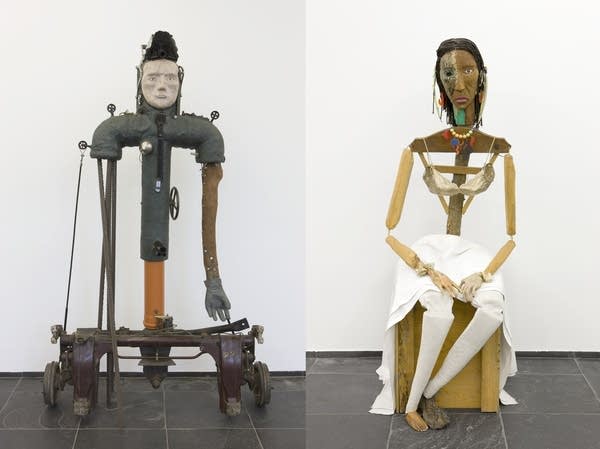Walker faces new Native art controversy

Go Deeper.
Create an account or log in to save stories.
Like this?
Thanks for liking this story! We have added it to a list of your favorite stories.
Native American artists from around the country are criticizing a new show opening at the Walker Art Center in Minneapolis.
"Jimmie Durham: At the Center of the World" features work from the 40-year career of an internationally lauded American sculptor. He identifies as Cherokee. But his critics say he is not Native, and is hurting artists who are.
The exhibit fills several galleries at the Walker. Created by the Hammer Museum in Los Angeles, the show is touring to four major cities. Vincenzo de Bellis, the Walker curator for the exhibit, says Durham is multifaceted.
"He's a poet, writer, an intellectual and also, and mainly, a visual artist," de Bellis said.
Turn Up Your Support
MPR News helps you turn down the noise and build shared understanding. Turn up your support for this public resource and keep trusted journalism accessible to all.
He is also prolific. There are sculptures, paintings, videos and installations. Many of the pieces take aim at the establishment. Often they are funny, and disturbing.
"Jimmie is extremely sarcastic in everything: when he speaks and when he makes the works. The exhibition has a lot of possibly funny works, but they are often dark humor," said de Bellis.
Durham makes sculptures from found objects. Near the center of the show stand two enormous figures. One is the conquistador Cortez, made from car parts, sheet metal and pulleys. Curator Anne Ellegood of the Hammer Museum said the other is Malinche, the Aztec woman sold to Cortez as a slave who became his interpreter and wife. Ellegood said Malinche is often portrayed as a traitor in Mexico, as opposed to an oppressed, enslaved, indigenous woman.
Durham claims Cherokee heritage. He never tried to enroll in any of the three Cherokee tribes, saying he objects to what he sees as an oppressive government system. A lot of his early work is about the struggle for Native rights. He was on the board of the American Indian Movement for years, but resigned and moved first to Mexico and later Europe. While he's well known and broadly exhibited there, this is his first major show in the United States in 30 years.

One part of the exhibition gathers pieces in which he parodies the interest in collecting Native artifacts by creating assemblages of animal skulls, fur and feathers with legs made from pieces of construction and police barricades. He has a full-length nude self-portrait as a native man.
Now in his late 70s, Durham has long been a subject of controversy among Native artists.
"It's not that he's like claiming to be Native," said Cherokee artist America Meredith. "He's claiming to be the Native. He's claiming to be the spokesperson for all Native American people. And that's offensive."
Meredith is based in Norman, Okla., and edits First American Art Magazine, devoted to indigenous artists. Meredith said researchers cannot find any Cherokee connection at all to Durham. She said the way the art world characterizes him as a Native artist is damaging.
"Art historians have really latched onto him. And he represents us. He's occupying a space. He's written more about than any actual Cherokee artist in the literature," she said.
Some Minnesota-based Native artists approached the Walker last year with concerns about the Durham show. One was choreographer Rosy Simas, who has presented work at the Walker. She is Seneka. She says there are very few visual arts shows by Native artists at the Walker.
"It has always been very heartbreaking to never see myself reflected in the work there," she said.
The Hammer Museum recognizes that Durham is not an enrolled Cherokee, said Anne Ellegood.
"Curatorially and in the field of contemporary art, we allow for self-identification," she said. "We have just operated from the position that this is Jimmie's history."

Ellegood said the research that suggests Durham may have no Native roots opens an opportunity for a broader conversation, and the Walker said it's looking for appropriate ways to do that. Artist Edgar Heap of Birds is a Cheyenne tribal member from Oklahoma. He's been Durham's friend for many years, and has exhibited with him in Europe. He described his friend's work as unique and honest, but when asked about the controversy, he sighed.
"I think it was probably hurtful to him," he said.
Heap of Birds will deliver the show's opening lecture Saturday afternoon.



